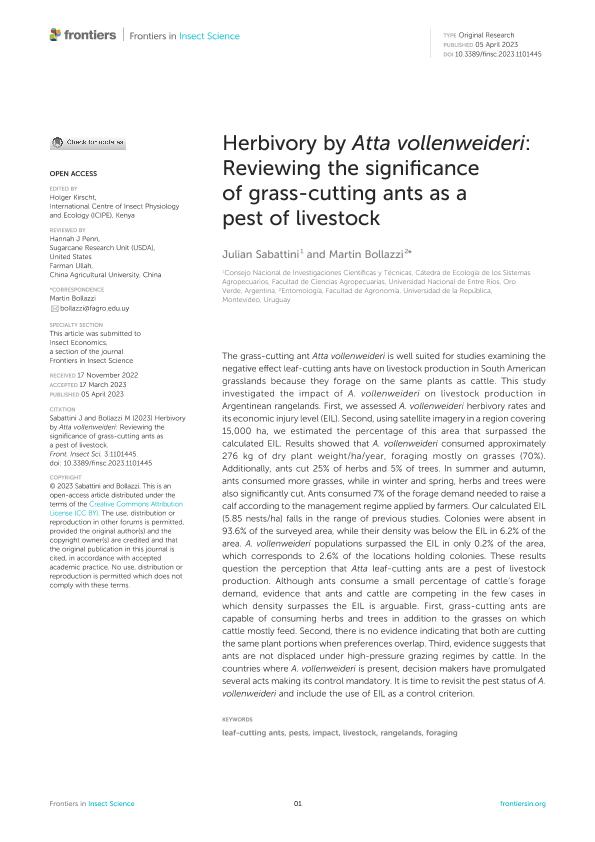Artículo
Herbivory by Atta vollenweideri: Reviewing the significance of grass-cutting ants as a pest of livestock
Fecha de publicación:
04/2023
Editorial:
Frontiers Media
Revista:
Frontiers in Insect Science
e-ISSN:
2673-8600
Idioma:
Inglés
Tipo de recurso:
Artículo publicado
Clasificación temática:
Resumen
The grass-cutting ant Atta vollenweideri is well suited for studies examining the negative effect leaf-cutting ants have on livestock production in South American grasslands because they forage on the same plants as cattle. This study investigated the impact of A. vollenweideri on livestock production in Argentinean rangelands. First, we assessed A. vollenweideri herbivory rates and its economic injury level (EIL). Second, using satellite imagery in a region covering 15,000 ha, we estimated the percentage of this area that surpassed the calculated EIL. Results showed that A. vollenweideri consumed approximately 276 kg of dry plant weight/ha/year, foraging mostly on grasses (70%). Additionally, ants cut 25% of herbs and 5% of trees. In summer and autumn, ants consumed more grasses, while in winter and spring, herbs and trees were also significantly cut. Ants consumed 7% of the forage demand needed to raise a calf according to the management regime applied by farmers. Our calculated EIL (5.85 nests/ha) falls in the range of previous studies. Colonies were absent in 93.6% of the surveyed area, while their density was below the EIL in 6.2% of the area. A. vollenweideri populations surpassed the EIL in only 0.2% of the area, which corresponds to 2.6% of the locations holding colonies. These results question the perception that Atta leaf-cutting ants are a pest of livestock production. Although ants consume a small percentage of cattle’s forage demand, evidence that ants and cattle are competing in the few cases in which density surpasses the EIL is arguable. First, grass-cutting ants are capable of consuming herbs and trees in addition to the grasses on which cattle mostly feed. Second, there is no evidence indicating that both are cutting the same plant portions when preferences overlap. Third, evidence suggests that ants are not displaced under high-pressure grazing regimes by cattle. In the countries where A. vollenweideri is present, decision makers have promulgated several acts making its control mandatory. It is time to revisit the pest status of A. vollenweideri and include the use of EIL as a control criterion.
Palabras clave:
FORAGING
,
IMPACT
,
LEAF-CUTTING ANTS
,
LIVESTOCK
,
PESTS
,
RANGELANDS
Archivos asociados
Licencia
Identificadores
Colecciones
Articulos(SEDE CENTRAL)
Articulos de SEDE CENTRAL
Articulos de SEDE CENTRAL
Citación
Sabattini, Julian Alberto; Bollazzi, Martin; Herbivory by Atta vollenweideri: Reviewing the significance of grass-cutting ants as a pest of livestock; Frontiers Media; Frontiers in Insect Science; 3; 1101445; 4-2023; 1-10
Compartir
Altmétricas




